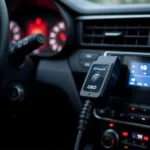The OBD2 plug, often referred to as the OBD2 port or OBD2 connector, is a standardized 16-pin interface found in most vehicles manufactured after 1996. It serves as the gateway for accessing your vehicle’s onboard diagnostic system, allowing mechanics and car enthusiasts to retrieve valuable information about the engine, emissions, and other critical systems.
But why is it called the “OBD2 plug”? Let’s delve into the history and significance of this ubiquitous automotive component.
A Brief History of On-Board Diagnostics (OBD)
Before we unravel the name, it’s essential to understand the evolution of on-board diagnostics. The earliest forms of OBD emerged in the 1960s with rudimentary systems monitoring specific components. However, the lack of standardization made diagnostics a challenge.
Fast forward to the 1980s, California Air Resources Board (CARB) introduced stricter emission standards, leading to the development of OBD systems capable of detecting and reporting emission-related faults. This marked the first significant step towards standardized vehicle diagnostics.
Building upon this foundation, the Society of Automotive Engineers (SAE) developed OBD2 in the early 1990s, introducing a universal connector and communication protocol. The “2” in OBD2 signifies the second generation of this technology.
Decoding the “OBD2 Plug” Name
Now, let’s break down the name “OBD2 plug”:
- OBD2: This acronym stands for “On-Board Diagnostics, generation 2,” indicating the specific iteration of the diagnostic system.
- Plug: This term accurately describes the physical interface itself. It’s a plug, or connector, that facilitates communication between the vehicle’s computer and external diagnostic tools.
Therefore, the name “OBD2 plug” is a straightforward description of its function and generation. It’s a plug used for accessing the second generation of on-board diagnostic systems in vehicles.
Where Can You Find the OBD2 Plug?
In most vehicles, the OBD2 plug is located under the dashboard on the driver’s side. However, the exact location can vary depending on the make, model, and year of your vehicle. If you’re having trouble locating it, consult your owner’s manual or search online for your specific vehicle.
What Does the OBD2 Plug Do?
The OBD2 plug serves as a communication portal to your vehicle’s engine control unit (ECU). When you connect an OBD2 scanner, it can retrieve diagnostic trouble codes (DTCs), which are standardized codes that indicate specific faults or malfunctions detected by the system.
Beyond retrieving DTCs, the OBD2 plug enables access to a wealth of real-time data, including:
- Engine RPM
- Vehicle speed
- Coolant temperature
- Oxygen sensor readings
- Fuel system status
This information is invaluable for mechanics diagnosing problems, monitoring vehicle performance, and ensuring your car runs smoothly.
Conclusion
The seemingly simple name “OBD2 plug” belies the crucial role it plays in modern vehicle diagnostics. It’s the standardized gateway to a treasure trove of information about your car’s health and performance. Understanding its function and history empowers car owners and mechanics to diagnose problems accurately and keep vehicles running efficiently.
If you’re interested in learning more about OBD2 scanners, their capabilities, or how to use them effectively, explore the wealth of resources available on OBDFree. We’re dedicated to providing you with the knowledge and tools to take control of your vehicle’s diagnostics.
FAQs About OBD2 Plugs
1. Can I use any OBD2 scanner with my vehicle?
While the OBD2 plug is standardized, the software and capabilities of OBD2 scanners can vary. It’s essential to choose a scanner that’s compatible with your vehicle’s make, model, and year.
2. What should I do if my OBD2 scanner isn’t working?
First, ensure the scanner is properly connected to the OBD2 plug and your vehicle’s ignition is turned on. If the problem persists, check the scanner’s documentation for troubleshooting tips.
3. Can I clear DTCs using an OBD2 scanner?
Yes, most OBD2 scanners allow you to clear DTCs. However, it’s important to address the underlying issue that triggered the codes in the first place.
4. Is it safe to use an OBD2 scanner while driving?
It’s not recommended to use an OBD2 scanner while driving, as it can be distracting. Always park your vehicle in a safe location before accessing the diagnostic system.
5. Where can I find more information about OBD2 plugs and scanners?
OBDFree offers comprehensive resources and reviews on OBD2 scanners, helping you make informed decisions about choosing and using these diagnostic tools.
Looking for more information? Check out these resources:
Need further assistance? Our team is here to help!
Contact us:
- WhatsApp: +1(641)206-8880
- Email: [email protected]
We offer 24/7 customer support to address all your OBD2-related queries.

